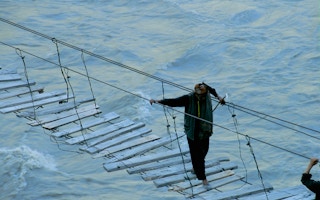Litter, uncollected garbage and foul odours are testament to the ordeal facing residents of Chashma Goth near Ibrahim Hyderi, a fishing village in Karachi’s Korangi district.
They have learnt to live with poverty, lack of education and unemployment, but in recent years they also had to deal with untreated wastewater – both domestic sewage and industrial effluent – from the Pakistani megacity’s 16 million-plus population flowing right through the village before ending up in the Arabian Sea.
“People living along Karachi’s coastal belt are facing manmade disasters, more than the impacts of climate change,” says Ameer Ali, a 36-year-old worker at the local fish-processing factory, as he points to animal carcasses lying behind young mangroves. “Till just 10 years ago, catching fish nearby was not a difficult task.”
Now the fishers have to go to the deep sea. Ali blames the authorities for discharging the city’s sewage untreated into the sea. Fish have moved away, and “I am among the thousands of fishers who left their original profession, and are searching for other means of livelihood”, he says.
“
Earlier, there were seven types of mangrove plants; now our coastal area has only four. Our government institutions must make a serious effort if they want to save ecosystems that are billions of years old.
Rafiul Haq, plant ecologist, International Union for Conservation of Nature
Marine life in danger
Moazzam Ali Khan, a marine expert associated with WWF, tells The Third Pole that this is not the case only in Chashma Goth, but all along a 10km stretch of coast that includes Rehri Goth, Ibrahim Hyderi, Korangi fish harbour, Landhi Cattle Colony and Gizri Creek.
“Untreated sewage has made the surroundings of this coastal belt devoid of animals. You can no longer find shrimps, fish and other marine animals in a radius of five to seven kilometres. Marine life had been thriving here for millions of years, but vanished during the last 20 years, due to untreated water.”
Khan points out that lamp shells, a type of small shellfish that had survived around Karachi Fish Harbour, Korangi Creek and Landhi for at least 20 million years, vanished in the past two decades, and many species of sponges, sea anemones, corals and jellyfish have also disappeared.
Seabed sediments along the Karachi coast have been found to be highly polluted. Anglers – who were a common sight at Native Jetty Bridge near the Port of Karachi 20 years ago – have abandoned the area. “Not only Indo-Pacific fish, but also a large number of other marine species, including Arabian pupfish, have disappeared in this area,” Khan says. He believes the reason is the wastewater dumped directly into the sea, which makes survival impossible for most marine life.
The coastal belt is suffering the most because Karachi is such a densely populated city with many factories. “Not so far away, Keti Bundar and Kharo Chan [two places where the Indus River flows into the Arabian Sea] are faring better,” Khan says. However, multiple studies have shown that those areas are experiencing salinity problems, as climate change raises sea levels and saltwater intrudes further inland.
According to a WWF report from 2019, Karachi produces around 475 million gallons per day (MGD) of wastewater, of which 420 MGD (88 per cent) is untreated.
“The entire sewage, after going through different drainage channels including [the] Lyari and Malir rivers, ultimately goes into the sea,” says Khan, adding that while Karachi has three plants for treating such effluent, they are all non-functional, even though last year the government of Sindh province committed to repairing them.
Mangroves harmed by sewage and effluent
Rafiul Haq, a consultant plant ecologist who is associated with the International Union for Conservation of Nature (IUCN)’s Commission on Ecosystem Management (CEM), tells The Third Pole that untreated sewage has eliminated three types of mangrove plants.
“These mangroves are a major source of nutrients and provide a diverse habitat for interdependent communities of invertebrates, fish, birds and reptiles,” he says, adding that the productivity of coastal areas with mangroves is seven times higher than those without.
“Earlier, there were seven types of mangrove plants; now our coastal area has only four. Our government institutions must [make a serious effort] if they want to save ecosystems that are billions of years old,” says Haq. The ecologist believes the best way to achieve this is for the government to make the treatment plants functional.
There are over 1,200 factories in Karachi, according to Ghulam Abbas, an assistant professor at the Centre of Excellence in Marine Biology at the University of Karachi. These include tanneries, foundries, metal processors, manufacturers of plastic, rubber, glass, ceramics, tiles, cement, textiles, pharmaceuticals, soap, fish-processing units and producers of fertilisers, pesticides and other chemicals.
“These chemicals have made our entire coastal belt poisonous, and no animal can live in this environment,” says Abbas, who has been studying the accumulation of pollutants in the creeks in Karachi that flow into the Arabian Sea.
Ismail Rahoo, minister for environment, climate change and coastal development in the Sindh provincial government, says that in order to make the free of sea pollution, the government plans to install a combined effluent treatment plant on a priority basis.
He tells The Third Pole that the main problem is that industrialists are not interested in following laws meant to safeguard the environment, and the government is preparing strategies to either force them to install new treatment plants or make existing ones functional again.
One example is the combined effluent treatment plant given to the Pakistan Tanners Association with help from the government of the Netherlands, which is now non-functional.
“We will do our best to save nature,” Rahoo says.
This story was published with permission from The Third Pole.

















